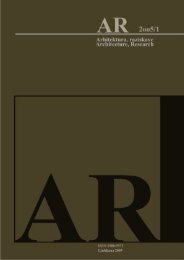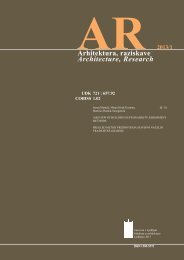AR 2010/1 - Fakulteta za arhitekturo - Univerza v Ljubljani
AR 2010/1 - Fakulteta za arhitekturo - Univerza v Ljubljani
AR 2010/1 - Fakulteta za arhitekturo - Univerza v Ljubljani
You also want an ePaper? Increase the reach of your titles
YUMPU automatically turns print PDFs into web optimized ePapers that Google loves.
Kaja Pogačar, Metka Sitar<br />
TIPOLOGIJA ČEZMEJNIH URBANIH OBMOČIJ<br />
<strong>AR</strong> <strong>2010</strong>/1<br />
Map 3:<br />
Karta 3:<br />
Aerial view of the former border-crossing Šentilj (SI) – Spielfeld (A). The<br />
area consists of 28ha which remained unused. Source: Karner, 2000.<br />
Pogled na območje nekdanjega mejnega prehoda Šentilj (SI) – Spielfeld<br />
(A). Območje obsega 28ha in ostaja neizkoriščeno.<br />
Map 2:<br />
Karta 2:<br />
Urban cross-border typologies: border-crossing, bi-national border towns,<br />
cross-border agglomerations, linear cross-border sites, urban exclaves.<br />
Čezmejne urbane tipologije: mejni prehodi, dvo-nacionalna obmejna mesta,<br />
čezmejne aglomeracije, linearni urbani predeli, čezmejne eksklave.<br />
Border-crossings<br />
Border-crossings are the most characteristic formations of crossborder<br />
typology from the recent past, which have, however,<br />
lost their primary function within the EU Schengen area. As<br />
urban entities, border-crossings are areas functioning as direct<br />
physical built contact between two neighbouring countries. In<br />
most cases, with the exception of bi-national border towns and<br />
some cross-border agglomerations of Western Europe, bordercrossings<br />
are located along important traffic routes, but usually<br />
away from dense urban areas. In the past, border-crossings gave<br />
the opportunity for developing certain crossing-related built<br />
structures. Along with structures, which in most cases enabled<br />
the border-crossing to function (customs, transportation,<br />
etc.), several supplementary services such as commercial<br />
and business were allocated. Border-related regulations often<br />
encouraged semi-criminal activities, such as the provision of<br />
pornography, alcohol, narcotics, including prostitution and other<br />
business. The Schengen Treaty enabled the gradual abolition<br />
of systematic border controls and the elimination of bordercrossing<br />
built structures, which created the opportunity for the<br />
redefinition and reuse of these areas from places of division into<br />
places of integration.<br />
In general, the territory of the EU, the loss of the primal<br />
function of border-crossings, and the new adjoining economic<br />
activities have changed the functions of cross-border areas in<br />
different ways. According to Krätke [1999], the immediate<br />
border areas could suffer from being ‘leapfrogged’ by new<br />
activities of cross-border cooperation. In the short run, there<br />
may be some negative effects on development of areas<br />
lying directly along the border, possible making them even<br />
more inferior. However, according to Hudnik [2004], in the<br />
long term, these areas could make use of their favourable<br />
strategic position to introduce new strategies for future<br />
spatial and functional development within the EU integration.<br />
Bi-national border cities (Twin-Cities)<br />
In a period of changes on the borders, pairs of towns lying on each<br />
side of national borders have increasingly drawn attention to their<br />
development. As products of development in different<br />
12

















